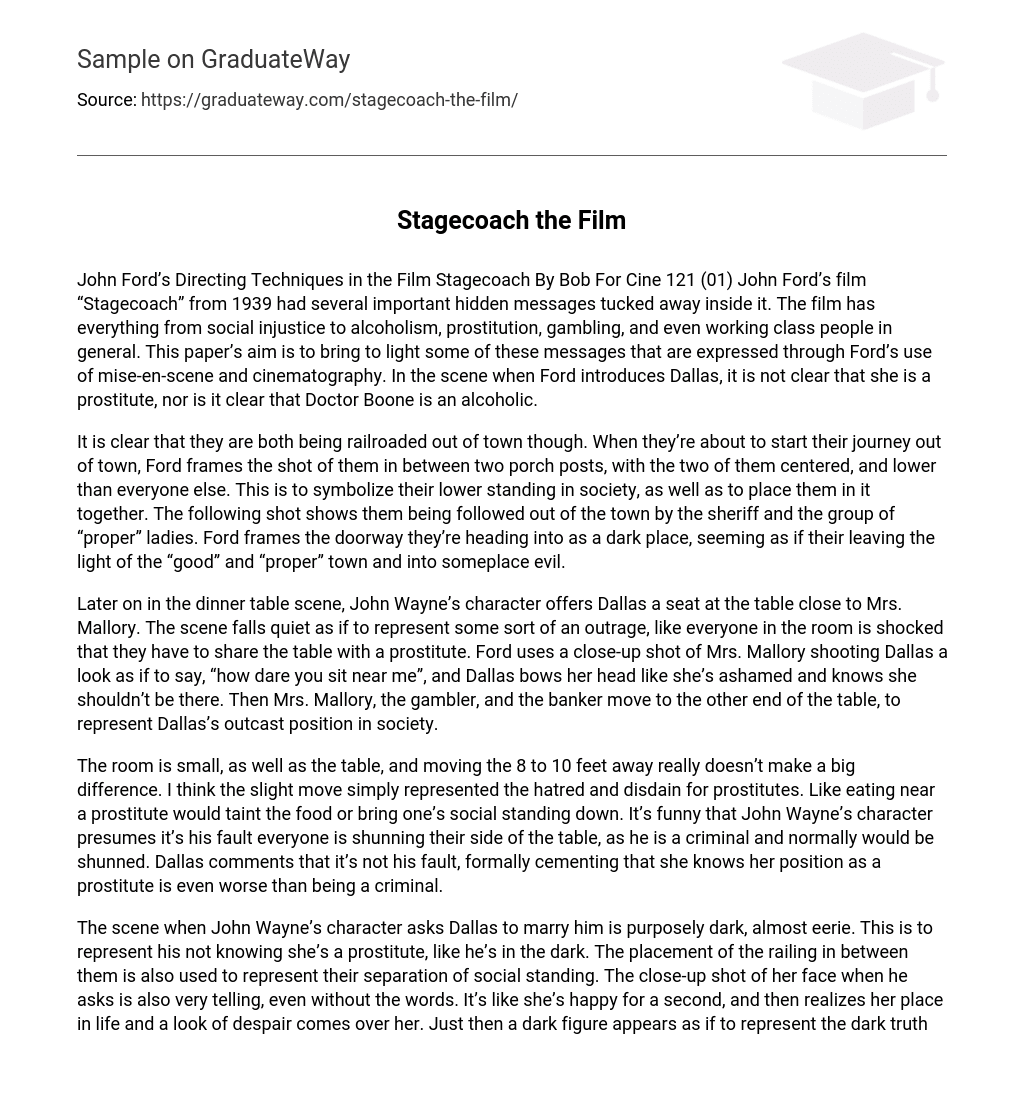John Ford’s Directing Techniques in the Film Stagecoach By Bob For Cine 121 (01) John Ford’s film “Stagecoach” from 1939 had several important hidden messages tucked away inside it. The film has everything from social injustice to alcoholism, prostitution, gambling, and even working class people in general. This paper’s aim is to bring to light some of these messages that are expressed through Ford’s use of mise-en-scene and cinematography. In the scene when Ford introduces Dallas, it is not clear that she is a prostitute, nor is it clear that Doctor Boone is an alcoholic.
It is clear that they are both being railroaded out of town though. When they’re about to start their journey out of town, Ford frames the shot of them in between two porch posts, with the two of them centered, and lower than everyone else. This is to symbolize their lower standing in society, as well as to place them in it together. The following shot shows them being followed out of the town by the sheriff and the group of “proper” ladies. Ford frames the doorway they’re heading into as a dark place, seeming as if their leaving the light of the “good” and “proper” town and into someplace evil.
Later on in the dinner table scene, John Wayne’s character offers Dallas a seat at the table close to Mrs. Mallory. The scene falls quiet as if to represent some sort of an outrage, like everyone in the room is shocked that they have to share the table with a prostitute. Ford uses a close-up shot of Mrs. Mallory shooting Dallas a look as if to say, “how dare you sit near me”, and Dallas bows her head like she’s ashamed and knows she shouldn’t be there. Then Mrs. Mallory, the gambler, and the banker move to the other end of the table, to represent Dallas’s outcast position in society.
The room is small, as well as the table, and moving the 8 to 10 feet away really doesn’t make a big difference. I think the slight move simply represented the hatred and disdain for prostitutes. Like eating near a prostitute would taint the food or bring one’s social standing down. It’s funny that John Wayne’s character presumes it’s his fault everyone is shunning their side of the table, as he is a criminal and normally would be shunned. Dallas comments that it’s not his fault, formally cementing that she knows her position as a prostitute is even worse than being a criminal.
The scene when John Wayne’s character asks Dallas to marry him is purposely dark, almost eerie. This is to represent his not knowing she’s a prostitute, like he’s in the dark. The placement of the railing in between them is also used to represent their separation of social standing. The close-up shot of her face when he asks is also very telling, even without the words. It’s like she’s happy for a second, and then realizes her place in life and a look of despair comes over her. Just then a dark figure appears as if to represent the dark truth in the scene or the skeleton in the closet, and Dallas runs off.
Almost like the dark truth appearing was trying to save John Wayne’s character from making a mistake at the last moment, without outright saying Dallas is a prostitute. The scene where Ringo Kid is walking Dallas to her home is also a very dark one. I think this is to represent that they’re going to an unpleasant place. The sounds heard during the walk are also kind of eerie. There is laughing and music heard, but almost like the laughing is directed at her for thinking she could get married. The laughing is also kind of an eerie laugh, as if to represent that where she lives is an unsavory place.
The woman sitting on the steps is blond like Dallas, just a bit older and more worn out, to represent what her life will be like if she continues on the same path. The inside of the house is framed within a frame and the glass is broken, with the room very smoky. I think this was done to represent her broken and shady past. Almost like that one shot sums up her past and her future. When they get to her home there are missing boards in the walkway. I think this was done to represent the missing truths that Dallas has been keeping from the Ringo Kid.
This shot is also very dark and there is a feeling that she’s headed for a bad place. I think all this was done to represent that Dallas is a prostitute, without coming right out and saying it. There are many other subtle techniques used throughout the film to represent several other social injustices. Such as the treatment of Buck, who never gets a chance to speak his mind. I think this was used to represent the treatment of the working class in society, and how they don’t have much say. The scene where Mrs. Mallory says she’s seen that silver cup before represented to me that gambling is kind of like stealing.
There are many scenes when Doc Boone is drunk and appears to not be able to control himself, representing the evils that alcohol brings even on the best of people and professions. Even the banker gets arrested in the end, representing how bankers are crooks and thieves. John Ford did an excellent job directing this film in my opinion. Especially for being filmed in 1939. He showed how the use of mise-en-scene and cinematography could take the place of actual words. I also feel like many films today have lost that special characteristic. I think it takes all of the fun out of figuring out the movie and leaves little to the imagination.





